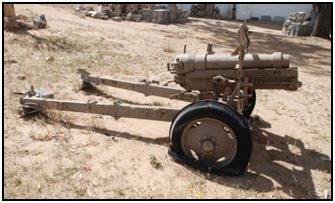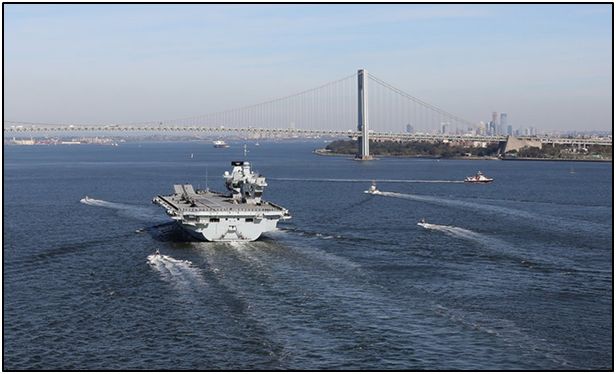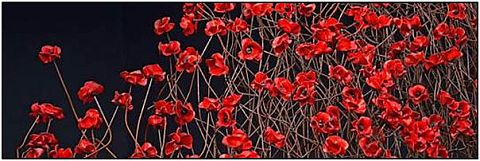


Newsletter/Nuusbrief 171
December/Desember 2018
The November meeting took place in Port Elizabeth on Saturday 10th November. During the morning members visited three churches to look at military commemoration plaques. The first was the Anglican Cathedral of St Mary the Virgin, where members and their guests were given a most informative guided tour of this historically richly endowed church by Margaret Harradine. This was followed by a visit to St Augustine’s Catholic Cathedral, where we were addressed by parishioner Kaye Henrick. We were welcomed by the verger Brian Phipps at St Paul’s Parish Churchand guided by Malcolm Kinghorn. En route through town, the group viewed the commemorative plaque on the outside of Hill Street Presbyterian Church. Lunch was shared in the parish hall of St Paul’s where the afternoon meeting also took place.
The morning was organised by Dennis Hibberd, Richard Tomlinson, Ian Pringle, Franco Cilliers and Malcolm Kinghorn to whom our thanks are due. We also thank Brian Klopper for leading the Act of Remembrance and congratulate him on his appointment as the National President of the South African Legion of Military Veterans. The SA Legion also expressed its thanks to SAMHSEC for its donation to their Poppy Collection.
Members’ slot
In the member’s slot, Anne Irwin used excerpts of poetry to illustrate attitudes towards peace ranging from the American Civil War to more recent times. She mentioned that throughout history, the desire for an end to hostilities has been so strong that when it comes, dead soldiers have been honoured by the erection of monuments hailing their bravery and their ultimate sacrifice for the benefit of the living. She centred her presentation on a specially embossed Bible that had been given to her great aunt. This commemorated the peace celebrations in 1919 when a victory parade, in which nearly 15 000 troops participated, took place in London.
The curtain raiser and the main lecture were combined. Pat Irwin presented an illustrated talk titled The Great War 1914-1918: The end and after the end.
After briefly recounting the factors which led to the Great War and the positions and strengths of the combatants, the talk moved to 1917. At this point there was a digression to examine the impact and consequences of the British Naval Blockade and the U-boat war, including famine and starvation on the European continent and food shortages in Britain. The U-boat campaign also brought America into the War in April 1917. The subject then moved on to discuss the ‘Eastern’ Front and its significance to the war as a whole. Brief mention was made of the two 1917 Russian Revolutions and their consequences as well as the collapse of the Russian army. These events resulted in the Treaty of Brest-Litovsk and the ceding of much Russian territory to the Central Powers. This significant victory enabled Germany to transfer large numbers of men and equipment to the Western Front which in turn was seen as an opportunity to break the three-year stalemate before the arrival of American troops and matériel. The intention was initially to knock Britain out of the war, at which point it was assumed the French would sue for peace.
The result was the Spring Offensive(known also as Operation Michael or the Kaiserschlaght) starting on 21st March 1917, in which specially trained ‘Stormtroopers’ rapidly overran allied positions. The offensive ran until July by which time Allied resistance had stiffened, American troops had arrived and German logistics and supplies had been unable to keep up with their army. The German army was halted at the (Second) Battle of Marne and by August was forced to retreat in what became known as the 100-day Campaign to the Allies. Under growing pressure,the German army fell further and further back until even their strongly fortified Hindenberg Line was breached.
The German army’s position was further weakened by threemajor factors: a realisation among the Higher Command that the war could no longer be won; civil unrest among the German civilian population as famine, starvation and general war weariness made themselves felt;and the impact of the 1918 deadly influenza pandemic which, although it affected all the armies, was probably more severe among the Germans as they did not have the manpower reserves which the Allies had. The final blow to Germany, which made it virtually impossible to continue the prosecution of the war, was the collapse of its allies. First Bulgaria, followed by the Ottoman Empire, sought individual armistices while the multi-ethnic Austro-Hungarian Empire essentially dissolved as elements within it declared themselves to be independent countries and too, sued for peace.
In late October a peace oriented civilian government in Germany dismissed the head of the army: On 4th November the Germans asked for an armistice and on 9th October the Kaiser was pressured to abdicate, the constitutional monarchy being replaced by a republican democracy of sorts. On 11th November representatives of the new government signed the Armistice in a Railway coach at Compiégne. Contrary to politically correct elements in the media in recent weeks claiming it had been a negotiated settlement, it was nothing of the sort. It was a list of demands presented to the Germans which gave them no option but to agree in full. Its harsh conditions formed the basis of the Treaty of Versaillessigned on 28th June 1919. The defeated powers had not been permitted to attend the ‘Peace’ conference or be part of any negotiation or decisions until they had been finalised. They were then presented with the decisions.
It was noted that while President Wilson of America favoured a lenient approach to Germany, France’s Poincare and Clemenceau demanded a harsh and retributive punishment which would virtually destroy her as an economic power. France’s Marshall Foch felt for example that the conditions were in fact far too lenient. Britain’s Lloyd George wanted a softer approach but under political pressure from his own constituency, went along with the French positions. Among these conditions were a clause in which Germany had to accept full guilt for the war, massive reparations, disarmament and surrender of her fleet: Britain wanted to ensure her world dominance in trade and continue to ‘rule the seas’.
There was widespread criticism of the Treaty at the time, not only in Germany. It has subsequent been widely seen as primarily vengeful, unrealistically punitive, a significant factor in the rise of Nazism and, indirectly, among the causes of the Second World War. Both Wilson and General Smuts had at the time it was drafted, warned that it would lead to another war, but in the face of Anglo-French intransigence, this fell on deaf ears. The Germans refer to it as the ‘Versailles Diktat’. The talk concluded with a look at the changing maps of Europe and the Middle East, changes which were largely in the interests of Britain and France. The long shadows of these shenanigans and naked self-interest are still with us today – 100 years later.
Future meetings and field trips/ Toekomstige byeenkoms en uitstappe
The next regular meeting will be on Monday 10th December at 19h30 at the Eastern Cape Veteran Car Club in Conyngham Road, Port Elizabeth. The member’s slot will be used by Franco Cilliers to talk about the Bloemfontein night tank shoot. The curtain raiser will be by Barbara Kinghorn on the topic Face-Saving in 1918 – Anna Coleman Ladd’s Portrait-mask Studio in Paris. The main lecture will be given by Mac Alexander on the subject of An American connection - Romance lost and won in southern Africa at the start and end of the First World War.
Matters of general interest / Sake van algemene belang
New member / Nuwe lid
We welcome Lifetime Member Arnold van Dyk of Bloemfontein to the Eastern Cape Branch. We hope your association is a happy one and that you will be able to join us on some of our field trips.
Individual members’ activities / Individuele lede se aktiwiteite
Congratulations to Barry Irwin, who has been promoted to full professor at Rhodes University.
Members’ forum/Lede se forum
Fred Nel came across this gun in Springbok, Northern Cape and wonders if anybody can identify the type. The only markings on it are:6 Pdr, LM, 1908, FL191A

World War I Centenary Years / Eerste Wêreldoorlog Eeufeesjare
With the signing of the Armistice on 11th November 1918, there were no further First World War engagements, although some activity of a military nature continued throughout the following months. In terms of the Armistice, Germany withdrew its forces from all occupied territory, the Imperial German Navy was impounded in Scapa Flow and the Allies occupied some German territory. Disarmament processes also took place in all the former Central Powers. There were massive population movements in the former Austro-Hungarian Empire as it dissolved into about a dozen new countries. Germany also lost some of its eastern acquisitionsand parts of Prussia with consequent population displacements and redistribution.
In these contexts it is also worth briefly considering the nature of the Armistice agreement, bearing in mind that historically, the concept of an ‘armistice’ has been no more than an agreement to stop fighting while conditions for peace are discussed and negotiated.< It had never until November 1918 been used as a thinly disguised instrument of unconditional surrender as was presented to Germany by the Allies.
Britain and particularly France, saw the armistice as a first step in a process to permanently weaken Germany economically, militarily and politically. Its terms (summarised below) also constituted, in a harsher form, the content of the 1919 Paris Peace Conference in which the former Central Powers were not permitted to take part. One of the products of the Conference was the Treaty of Versailles which the German were forced to accept and sign on 28th June 1919. Only then was the naval blockade, which had resulted in an estimated 425 000 extra civilian deaths, many of whom were children, finally lifted.
A summary of the conditions demanded, and not open to any negotiation, at the 1918 Armistice:
Websites of interest/Webwerwe van belang
Ships
HMS Queen Elizabeth and cyberwarfare: Royal Navy's biggest warship, in New York to sink cybersecurity threats
Davey Winder Cybersecurity 21st October2018 (Trafalgar Day)
https://www.forbes.com/sites/daveywinder/2018/10/21/royal-navys-biggest-warship-hms-queen-elizabeth-in-new-york-to-sink-cybersecurity-threats/#4fc703b73866

HMS Queen Elizabeth, Britain's newest aircraft carrier and largest warship, enters New York Bay.
Russia’s only aircraft carrier, Admiral Kuznetsov is not a lucky ship. Prone to fires and breakdowns, it’s now been damaged by a collapsing crane and a sinking dry dock.
Jamie Seidel news.au.com 31st October 2018
https://www.news.com.au/technology/innovation/military/hole-ripped-in-russian-carriers-side/news-story/90917c29698ed02b03780f35ba01db8c
Russia's dry dock accident could have far larger repercussions than a damaged carrier
Tyler Rogoway The Drive@Aviation_Intel 30th October 2018
http://amp.timeinc.net/thedrive/the-war-zone/24572/russias-dry-dock-accident-could-have-far-larger-repercussions-than-a-damaged-carrier?utm_source=quora&utm_medium=referral
Helge Ingstad: Norway's warship collides with tanker in fjord
Anon BBC News Europe 8th November 2018
https://www.bbc.com/news/world-europe-46136564
The elite warship that collided with a massive tanker on its way home from NATO's big war games unexpectedly sank overnight
Ryan Pickrell Business Insider 13th November 2018
https://www.businessinsider.com/norways-elite-frigate-sinks-after-damages-from-devastating-collision-2018-11?IR=T
For photographs see also: Ryan Pickrell Business Insider 19th October 2018
https://www.businessinsider.com/check-out-these-photos-of-the-hms-queen-elizabeth-carrier-in-new-york-2018-10?IR=T
World War I
The moment the guns fell silent: Eerie WW1 recording captures exact second the chaos of war stopped dead... to be replaced by beautiful birdsong
Amie Gordon MailOnline 8th November 2018
https://www.dailymail.co.uk/news/article-6366499/amp/WW1-recording-captures-second-chaos-war-stopped-dead.html
Bash the Boche: Historic events of 100 years ago as they would have been reported in The Sun at that time
Anon The Sun [UK] 9th November 2018
https://www.thesun.co.uk/news/7697725/world-war-one-centenary-read-reported-sun/
[Please note: this is a tongue-in-cheek view – Eds]
'Not all people are bad': A lesson from the 1918 Spring Offensive
Anon Independent IE 18th November 2018
https://www.independent.ie/life/world-war-1/not-all-people-are-bad-a-lesson-from-the-1918-spring-offensive-36758082.html
The weapons of the Somme in the Valley of the Boyne
Graham Clifford Independent IE 18th November 2018
https://www.independent.ie/life/world-war-1/the-weapons-of-the-somme-in-the-valley-of-the-boyne-30490401.html
Reflections on the First world war and Armistice Day: On the 100th anniversary of the end of the First World War, readers share their thoughts on how the conflict shaped history
Mike Scott The Guardian 9th November 2018
https://www.theguardian.com/world/2018/nov/09/reflections-on-the-first-world-war-and-armistice-day
Lost for words: Irish writing on the First World War
Fintan O’Toole The Irish Times 5th May 2015
https://www.irishtimes.com/culture/heritage/lost-for-words-irish-writing-on-the-first-world-war-1.2190779
Out of the wasteland: the First World War and modernism: The evolution of modernist literature was intimately bound up with the shock and devastation of the war
Suzanne Lynch The Irish Times 5th May 2018
https://www.irishtimes.com/culture/heritage/out-of-the-wasteland-the-first-world-war-an
d-modernism-1.2190829
World War II
How the world’s only feudal lord outclassed the Nazis to save her people [The story of Dame Sybil]
Lucas Reilly Mental Floss 6th November 2018
http://mentalfloss.com/article/559912/dame-sybil-hathaway-sark-feudal-lord-outclassed-nazis-ww2
Vietnam War
The sun set off 4 000 sea mines during the Vietnam War
Sarah Laskow Atlas Obscura November 14, 2018
https://www.atlasobscura.com/articles/solar-storm-sets-off-mines
French Prime Minister visits site of Vietnam 1954 Dien Bien Phu battle
Anon BBC News Asia 3rd November 2018
https://www.bbc.com/news/world-asia-46084006
Cold War and post-Cold war
The Cold War bunkers that cover a country [Albania]
Stephen Dowling BBC Future 2nd November 2018
http://www.bbc.com/future/story/20181102-the-cold-war-bunkers-that-cover-a-country
Resource materials of military historical interest/
Bronmaterieël van
krygsgeskiedkundige belang
POPULAR PUBLICATIONS
The October 2018 issue of South African Country Life has an interesting article on the ‘Spitfire Ace of the Karoo’ and Battle of Britain pilot, Group Captain Petrus (aka ‘Dutch’ or ‘Khaki’) Hugo. This is well worth reading.
Members are invited to send in to the scribes, short reviews of, or comments on, books, DVDs or any other interesting resources they have come across, as well as news on individual member’s activities. In this Newsletter, there have been contributions by Richard Tomlinson, John Wilmot, Malcolm Kinghorn, Barry Irwin, Michael Heywood, Michael Irwin, and Peter Duffel-Canham
| Chairman: | Malcolm Kinghorn | culturev@lantic.net |
| Secretary: | Franco Cilliers | Cilliers.franco@gmail.com |
| Scribes: | Anne and Pat Irwin | p.irwin@ru.ac.za |
TAILPIECE:

Part of the artwork of ceramic poppies titled Blood Swept Lands and Seas of Red commemorating Armistice Day 2018.
It will become a permanent exhibit at the Imperial War Museum in Manchester, UK.
This is part of the art installation Blood Swept Lands and Seas of Red, which was placed in the moat of the Tower of London in 2014 to commemorate the centenary of the outbreak of the Great War. It consisted of 888 246 ceramic poppies – each one representing a British or Empire soldier who died during the conflict.